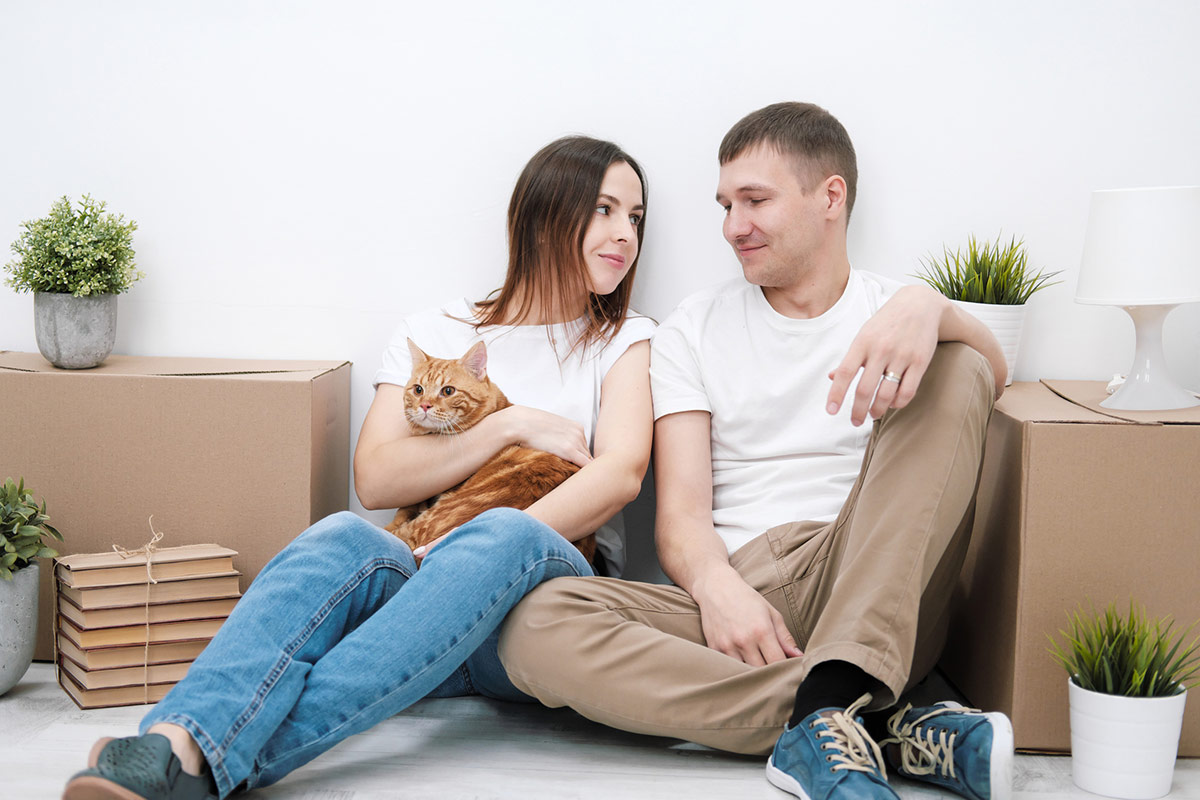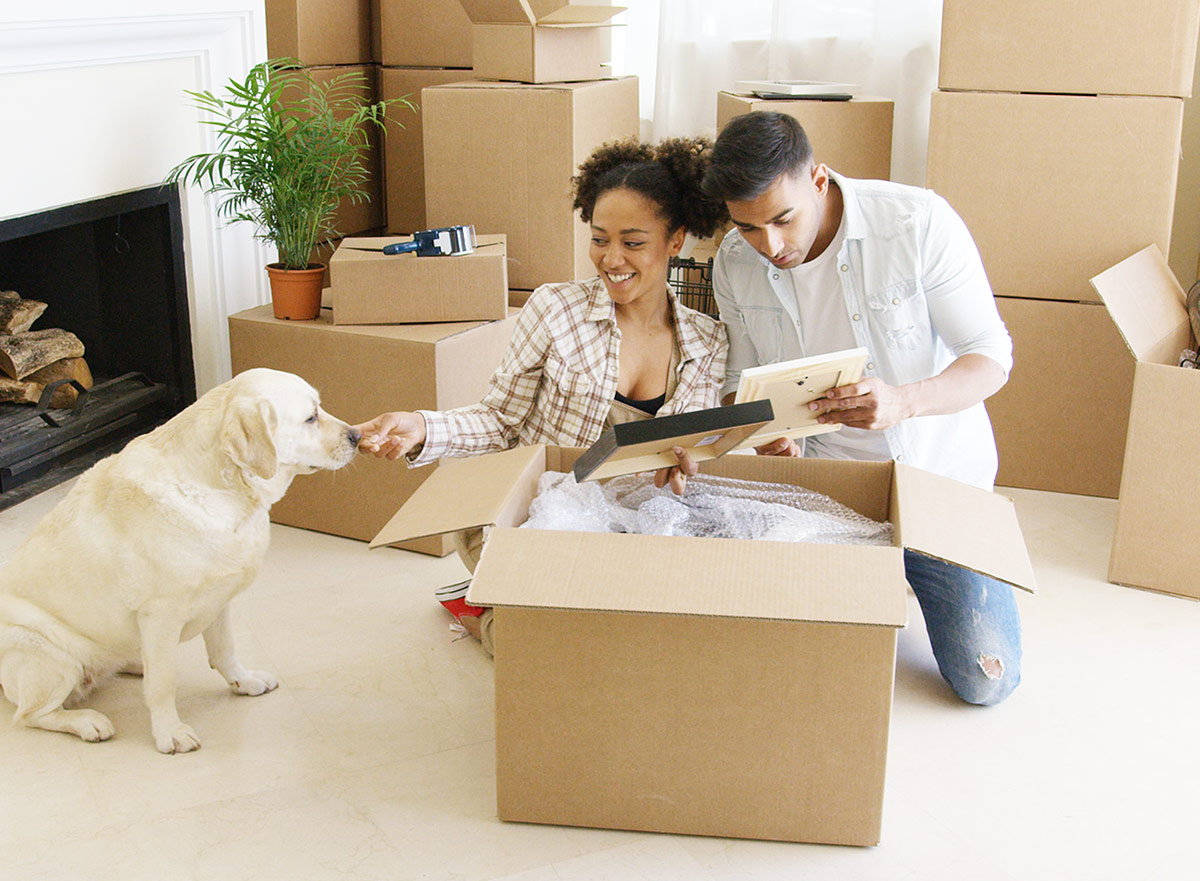For many of us our pets play an important role in our lives. As an integral part of the household we regard our pets as another member of the family. When facing the stress and upheaval of moving then, it stands to reason that you’ll want to minimise disruption and keep the stress levels of your pets as low as possible. Our advice will help them to settle calmly and quickly into their new home environment.

We’re a nation of pet lovers
The RSPCA estimates that 44% of UK households have pets, equating to a total number of 51 million pets. Dogs are a more popular choice than cats, with 9 million pet dogs in the UK compared to 8 million pet cats.
Whether it’s cats, dogs, rabbits, guinea pigs or something more exotic, it’s important to try and minimise the disruption caused to your pets when moving home. Minimising disruption will help to keep their stress levels low which makes for happier, healthier pets who'll settle into their new home with ease.
How to tell when pets are stressed or anxious
- Dogs may bark more than usual or become more aggressive.
- Cats may hide away or howl.
- Cats may become skittish or more aggressive than usual.
- Both cats and dogs may whine or lick more than usual.
- Changes in toileting habits.
- Destructive behaviour in dogs, for example chewing furniture.
- Displacement behaviour, mainly in dogs may cause them to fixate on something else, like a stick or toy.
Create a calm environment
Pets generally thrive in a calm and stable environment, so introducing them to the new home in a way that helps to build their trust is crucial. Shoving them through the door then shouting at them to move out of the way as large items of furniture are brought in probably isn’t going to make for a calm, happy introduction to their new home, so think carefully about how your pets will feel when entering the new family home for the first time.
Both dogs and cats are likely to need lots of reassurance and love, so make sure you have some time set aside to give them the reassurance they need and give them the opportunity to explore their new home calmly and safely. There are some great tips from Battersea about dealing with stress in dogs.
Giving your pet lots of reassurance will help make them feel that the new environment is safe and which will build their confidence, allowing them to settle in and feel at home faster.
Treats, plenty of praise and cuddles should help. For cats, you might want to try a pheromone product like Feliway, which is said to help reduce stress.
Tips for reducing stress moving house with your cat
- Try to keep your routine the same in the run up to the move, sticking to the usual feed times etc.
- Create an area of your house that your cat can safely stay in during the move, a spare bedroom is ideal but make sure you move your cat’s familiar items in there, food bowl, bedding toys and litter tray.
- Create a safe area in your new home, again with all of your cat’s familiar items there and spend plenty of time in the room with them, stroking and reassuring them.
- Even older cats who have never messed before may have a toilet accident as a result of stress. It’s important not to tell them off and to be patient. Remind them of the location of their new litter tray and make sure it’s always accessible. If necessary, put out more than one litter tray.
- Outdoor cats should remain indoors for a week at the very least, though some advice recommends keeping them indoors for as long as 3 weeks. 1-3 weeks should give your cat enough time to regard the new house as home and increases the chance that when finally let out, they will know where to return to.
- Before letting your cat out, make sure you’ve checked your garden for plants that can be poisonous to cats, such as lilies. Find out what flowers and plants are poisonous to cats here.
To find out more about helping cats settle in after moving home, take a look at 6 essential tips for helping your cat move home.

Tips for reducing stress moving house with your dog
- Before you introduce your dog to your new home, make sure it includes your dogs scent. Putting your dogs bed, toys and so on inside your house before you introduce your dog will help him feel more at home.
- Give your dog lots of love and reassurance and remember the calmer you are, then the calmer they will feel. That’s why keeping your dog in kennels for a day or two during a frantic moving day could be better for them.
- Try not to leave your dog alone in the first few days, even if they don’t show signs of separation anxiety ordinarily, being in a new home could trigger more anxious behaviour in them.
- Dogs may exhibit some destructive behaviour, for example, chewing things. Don’t tell them off, instead distract them and give them reassurance. Behaviour like this is likely to be a result of temporary anxiety which can be overcome with love and patience.
- Before letting your dog out into the new garden make sure you’ve double checked to ensure it’s escape proof and also check for plants that may be poisonous to your dog. Take a look at house and garden plants poisonous to dogs.
For more information on helping dogs settle in after a move, take a look at helping your dog adjust to a new home.

For both cats and dogs, we’d recommend that you get their address updated on the microchip register a day or so before you move home, make sure you also update their insurance documents and get them registered with a vet in your new local area as soon as you can too.
Moving home?
Did you know that you can get an instant online conveyancing quote here or if your house is already on the market, also make sure you have a floorplan drawn up to maximise your chances of a fast sale.

